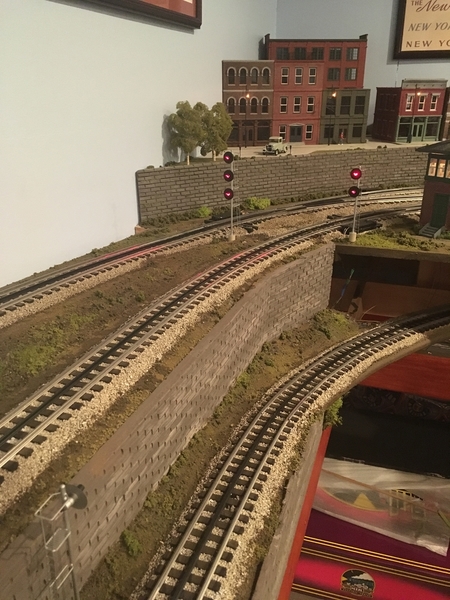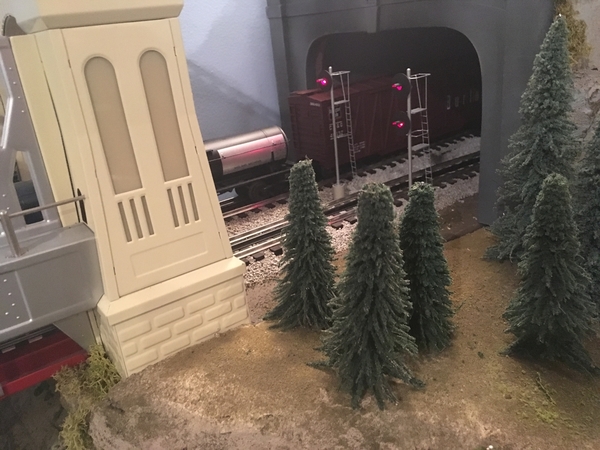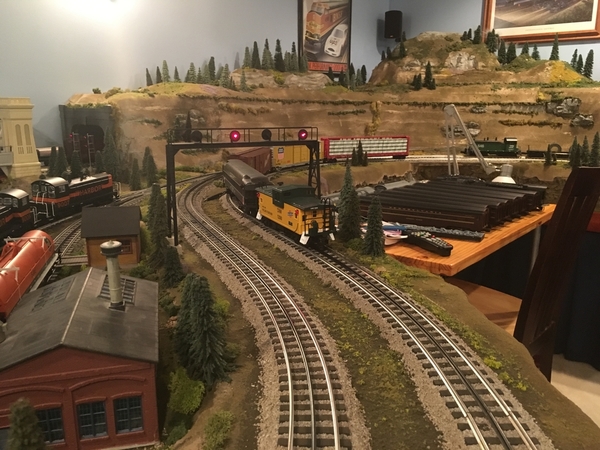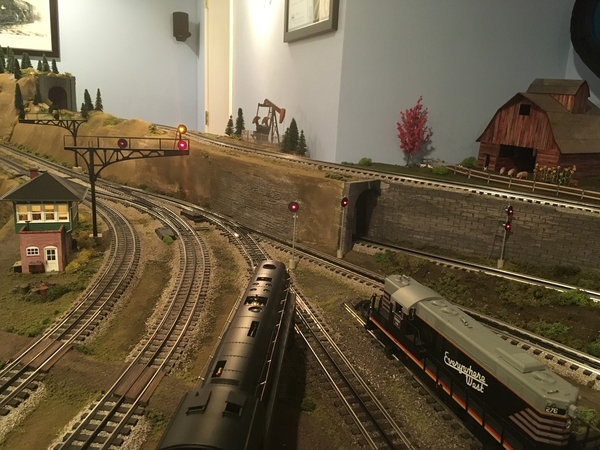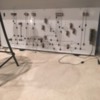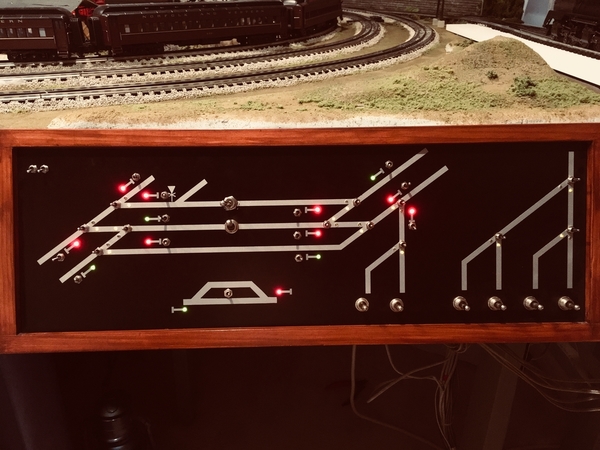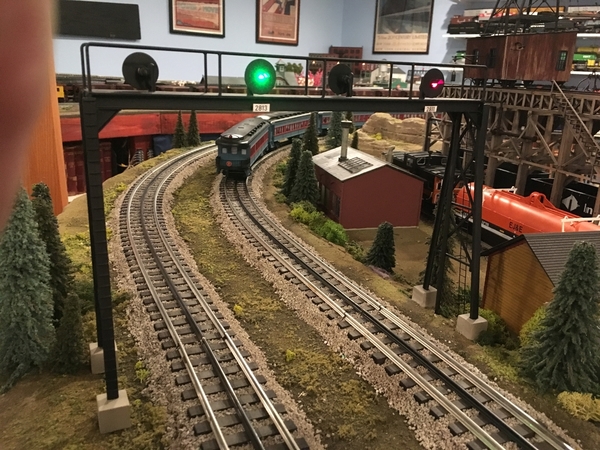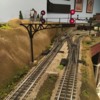Could you share a schematic for your signal system board so we can better understand the functions?
moed321 posted:I want to learn how to build boards like that. I am always impressed as to what people do to make signals work. How did you acquire your knowledge to build boards? Looks great. I also like the simplicity of the around the room double main, with large switches.
I can't speak for Mike, but I learned my basics on my childhood layouts and the rest trickled it's way into my mellon by chance.
I was surprised to ace the first test I took when applying for an assistants position and was soon hiring my own assistants. If you have a decent grasp of the basics, it's really just a jigsaw puzzle based on logic... fyi, they can usually be assembled in a number of ways too. I think that is were most folks balk in confusion. The same "look" and small size among modern components doesn't help put them at ease either, but I promise it isn't really as hard as it looks. Complicated? Sure..Hard? Not imo. It's still just "relays" (etc) in a new package
You might try a few Jameco kits as practice. They likely have quite a few breadboard projects that could be easily incorporated into a layout somewhere. (the board he uses is a solderable protyping board, breadboards are more of a temporary flavor, though they may be the final board used too). From there, it's all about the reference as to what each component can do... there are lots of options to choose from. Sometimes you build a ciruit to fit components, sometimes you fit componants into a ciruit. Refrence material for chips, etc. is an important part of making each next step easier. Short of schooling and daily exposure to it, just like with other train knowlwdge, you'll learn as you go.
Thanks for the comments and words of encouragement. I echo Adriatic's comment above on learning how to do this. I am not great at it, but still working on it. I will say having a decent soldering iron/ station and a solder sucker (for helping remove mistakes) were critical.
Kevster, the circuit is pretty simple, where there are two inputs, an H reference (for home block non-occupancy, one block past the signal) and a D (for distant block non-occupancy, 2nd block past the signal). If I had a chip burner, this could be greatly simplified to one chip, but I was not willing to purchase it for the few I needed made. My diagram is below. The H and D reference will be tied to a bigger logic circuit that ties the entire layout together, where relays help steer the from H and D block by switch indication to the proper signal head. I am also using an arduino to check the route exists (all switches are lined correctly) and the opposing signal at the control point for the same route is not cleared before allowing a better than red aspect. THe equations are shown on the bottom of the diagrams below. While the arduino logic is done and tested with an expanded shift register and the shown equations, the interface to the layout is not and is a work in progress. I will attach a picture of the logic diagram for this as well and progress on the board I am laying this out on. Each blue box on it represents a signal head and the colored arrows correspond to the H and D references on the signal driver diagram mentioned above. The west bound logic is close to being completed, where the east bound has not been started.
My original goal was to be able to show the wires for the H block (green wires) and the D block (orange wires) on this wiring board to guests and describe its functionality. As I have gotten more into this, I recognize this was not really practical and should have been done all in software, but I am committed now and staying the course. I am sure there are much easier ways to accomplish this, but this is where I am at.
E-Unit, my track diagram is correct and my inside loop is on the same grade. It looks confusing because of the passing siding hidden on the inside loop goes under the outside loop grade. I included some RR track shots below, one with berms and one with out to show it. What is hard to see is the on wall storage sidings, as they are also two levels and on top of each other.




Attachments
Thanks
Ok. Now I understand . Thanks Mike looks like a lot of fun there. Enjoy..
Hump Yard Mike posted:Thanks for the comments and words of encouragement. I echo Adriatic's comment above on learning how to do this. I am not great at it, but still working on it. I will say having a decent soldering iron/ station and a solder sucker (for helping remove mistakes) were critical.
Kevster, the circuit is pretty simple, where there are two inputs, an H reference (for home block non-occupancy, one block past the signal) and a D (for distant block non-occupancy, 2nd block past the signal). If I had a chip burner, this could be greatly simplified to one chip, but I was not willing to purchase it for the few I needed made. My diagram is below. The H and D reference will be tied to a bigger logic circuit that ties the entire layout together, where relays help steer the from H and D block by switch indication to the proper signal head. I am also using an arduino to check the route exists (all switches are lined correctly) and the opposing signal at the control point for the same route is not cleared before allowing a better than red aspect. THe equations are shown on the bottom of the diagrams below. While the arduino logic is done and tested with an expanded shift register and the shown equations, the interface to the layout is not and is a work in progress. I will attach a picture of the logic diagram for this as well and progress on the board I am laying this out on. Each blue box on it represents a signal head and the colored arrows correspond to the H and D references on the signal driver diagram mentioned above. The west bound logic is close to being completed, where the east bound has not been started.
My original goal was to be able to show the wires for the H block (green wires) and the D block (orange wires) on this wiring board to guests and describe its functionality. As I have gotten more into this, I recognize this was not really practical and should have been done all in software, but I am committed now and staying the course. I am sure there are much easier ways to accomplish this, but this is where I am at.
E-Unit, my track diagram is correct and my inside loop is on the same grade. It looks confusing because of the passing siding hidden on the inside loop goes under the outside loop grade. I included some RR track shots below, one with berms and one with out to show it. What is hard to see is the on wall storage sidings, as they are also two levels and on top of each other.
Mike, I very like your layout that how will progress !
I'm planning my new layout and I would like know if could you send me the file the Rrtrack, because all the ideas help me in my project !
Thanks,
Leandro
I really like your layout. Good Job! I remember seeing your layout in OGR.
Paul,
Just now seeing your comment. Thanks for the compliment!
Able to complete my last signal driver boards. This was unique because I needed to add some additional functionality to put signals to red, if route was cleared in the opposite direction, to simulate tumble down at intermediates signals between control points.
I am finally able to at least light all the signals.
Next focus is to complete work on the logic board which coordinates block occupancy, switch position and east/west bound directions
Attachments
The signals are looking great, Mike! The signal driver board takes me back 40 years ago breadboarding circuits for a small company! The panel looks nice
Wow! Awesome layout!! Definitely following your topic. You have a youtube channel ?
Thanks for the comments.
Kon, I do not have a you tube channel. I may have to look into that.
Thanks!
mike
Awesome, Mike!
Peter
Mike,
That is a lot of hard work, and the results shows that it is well worth it. Well done.
Thanks for sharing!
Alex
Things are finally starting to come together and is getting exciting.
I made my first video describing my progress. The signal system will have route specific aspects and not allow opposing absolute signals to be lined into each other.
In the following video, I have my first signal cleared at a control point since starting this project, where the two blocks are being monitored past signal along with having the correct route lined for the specific route that the specific signal head is governing movement over. Also when the signal is cleared it is tumbling the intermediate signals past it to the next control point for the opposite direction of travel.
Mike
Attachments
There are a couple of other efforts on the layout to work on still, but the signal system was the last major effort on my list of goals when I started.
Signal system is finally in service and controlled through the panel below. The indications for the signals are red or green, with a green indicating a route lined and requested.
I have not worked on this every weekend, but definitely put a lot of time in the effort for almost two years. While the original goal was a prototypical signal system, that is quite challenging and I settled on a 3 aspect system (red, yellow and green) with an additional restrictive aspect in a few of the heads ( flashing red). The signal aspects are route specific. Signal routes from one control point cannot have the opposing routes lined into them. There is also tumbledown for the intermediate signals between control points (well kind of, I tumble the blocks on off the signal request at the control point. One thing this system does not do is monitor the track between signals (OS) at control points. Initially I thought this would not be a big deal, but seeing it now, i wish I would have planned this differently to do this.
I built all the signals myself out of brass stock, styrene and chicken wire, with exception of some of the signals bridge pieces I used from the plasticville model. Each signal head has three different color surface mount leds (red, yellow and green).
The signals operate off of track indication, switch positions, signal requests and a clearing bit I created at each signals which is done through an arduino (this logic bit looks for switch positions per route and opposing route clear bits). All of this logic then sends yellow, green, red or flashing red logic to clustered locations on the layout where there I used the standard 74 series logic chips to interpret the logic and drive the signals. Well over 500’ of additional cat 5 cable was used to wire the system.
I also have semaphores that operate all three aspects. I did not build the semaphores, they are lionel ones in which I gutted the old solenoid, and have the arduino controlling servos for their operation. Small bug here still in my code I am still working through which causes a little bit of a delay in their response.

 I am also still working through producing some better signs on the ROW.
I am also still working through producing some better signs on the ROW.
I am very excited this is working now! This has been largest project effort on the layout to date.
I hope to post a video of the system in coming weeks.
Mike
Attachments
Looks Great. Looking forward to the 10th
Awesome work ! Nothing better than developing and making your own stuff !!
Very impressed with your abilities and your layout. Thanks for sharing so that so that I can use some of your ideas and methods for my layout someday.
Mike,
Your diligence and determination is second to none. Great work! Looking forward to the next video.
Dave
Thanks for the nice comments Steim. Happy to answer any additional questions.
Also appreciate your help on the cattle car.
Mike
Hump Yard Mike posted:
I am sure this old hat for many of you, but I was pretty excited on an area my wife and I completed over the last couple of weekends (been a while since any progress on layout). We picked up one of the tippi foam cutters to build walls with a brick pattern 24' long (3, 8' long sections ) for the back of layout. I think they came out really nice.
Staring with the pink foam Pattern
Giving them a texture with round handle dents and melting off the shark edges of bricks
Painting them dark grey and then working in rubbed light grey in certain areas for a more weathered look along with some green scenery grass
Area before the walls were placed
After installation
Hi Mike, I love your ideia !
I pretend to do this here in Brazil ! but I have a question !
What the size you used for each rock?
Thanks !
Hi Leandro,
I am not sure what you are asking? Are you looking for the size of the brick pattern?
Mike
Hump Yard Mike posted:Hi Leandro,
I am not sure what you are asking? Are you looking for the size of the brick pattern?
Mike
Mike, Yes !! Exactly this !
Thanks !
Leandro,
The vertical slots are roughly an inch a part and the horizontal slots are 5/16” of an inch apart. For long wall sections a long straight edge is important.
Thanks!
Mike


Attachments
Hump Yard Mike posted:Leandro,
The vertical slots are roughly an inch a part and the horizontal slots are 5/16” of an inch apart. For long wall sections a long straight edge is important.
Thanks!
Mike
Mike, Thank you !!!
Perfect !!
It was fun to visit your site again. I need to get going again. Thanks for all the past help, miss getting together.
tplee
Wow! this is so cool! ![]()












